Flying Training
Lesson 6: Turning
Saturday 26 November 2005 at 3:00pm with Neil Tucker in Citabria VH-RRW
Weather: clear. Scattered cloud at 3500 feet.
Click thumbnails to enlarge.
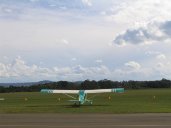 RRW |
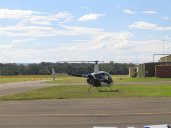 Helicopter |
The weather did not appear to be our friend this weekend. For weeks I've been planning to fly down to Temora (as a passenger) where the Super Constellation was to be there. However with thunderstorms forecast for Saturday and wind and rain for Sunday I backed out of that idea by the middle of last week. Instead I booked my normal 9.30am lesson with Kerry.
This morning the rain was absolutely bucketing down, and Alexander's cricket was cancelled. However by midday it had cleared and the sun was out in Faulconbridge so I called Curtis, reasoning that I may as well try to fit in a lesson today in case tomorrow was rained out. I was able to get a 3pm flight with Neil Tucker (Kerry being absent) and I was quite happy with this as I'm sure it's good to have a range of instructors. I'd already spoken to Neil as he was going to be the pilot on the Temora trip.
As I drove down the skies looked amazingly clear, but as I'd checked the Camden TAF before leaving I knew that (a) it was going to be windy and (b) there was a 40% chance of thunderstorms from 2pm onwards. Here's my TAF decode (from Airservices Australia):
CAMDEN (YSCN) TAF YSCN 260015Z 0214 34015G25KT 9999 SCT035 FM13 18015KT 9999 LIGHT SHOWERS OF RAIN SCT025 SCT035 PROB40 INTER 0313 VRB20G40KT 3000 THUNDERSTORMS WITH RAIN SCT012 SCT040CB T 25 29 29 26 Q 1011 1009 1007 1006 METAR YSCN 260130Z AUTO 36008KT 9999NDV // ////// 24/17 Q1009 RMK RF00.0/002.2
which decodes as (times converted to local):
Camden
Terminal Area Forecast issued 11.15am for the 12 hours from 1pm to 1am
Wind from the NNW (340°) at 15 knots gusting to 25 knots
Visibility at least 10km; scattered cloud at 3500 feet
From midnight, wind from the south (180°) at 15 knots, with light showers of rain and scattered cloud at 2500 and 2500 feet
40% probability between 2pm and midnight of wind variable 20 knots gusting to 40 knots, visibility 3km, thunderstorms with rain, scattered cloud at 1200 feet and scattered cumulonimbus at (to?) 4000 feet
Temperatures (every 3 hours): 25, 29, 29 and 26°C
QNH (sea-level pressure): 1011, 1009, 1007 and 1006 hPa
Conditions at 12:30pm: wind from the north at 8 knots, visibility at least 10km (not sure what NDV means). QNH 1009
(The QNH is set on the altimeter before takeoff, so that altimeters on all aircraft are reading the same altitude - obviously desirable.)
The other preparation I did was to check the Citabria's demonstrated crosswind component on the manufacturer's web site. It's 17 knots [Note: Curtis sets a limit of 15 kts]. Here's a way of determining the crosswind component (from www.auf.asn.au):
Estimating Crosswind Component
Once you have determined your take-off direction and estimated the wind velocity:
- Estimate the wind angle. i.e. If you intend taking off towards the north
and the wind is coming from the north-east or north-west then the wind angle
is about 45°.
- The crosswind component is the windspeed multiplied by the sine of the
wind angle. However a reasonable approximation of the crosswind component is
made if you multiply the wind angle by 1.5 and apply the result as a
percentage [to maximum 100%] of the wind speed.
e.g. Wind speed 15 knots, wind angle 45°: Crosswind component = 45 x 1.5 = 67.5% of 15 = 10 knots
- If the wind angle is 60° or more consider the full wind speed as the crosswind component. i.e. wind speed 15 knots, wind angle 60° then crosswind component = 15 knots.
Bearing in mind that the runway at Camden is 60°, my reading of this
calculation is that we could expect an 8 knot crosswind
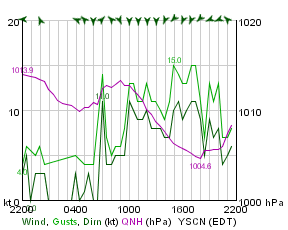 (ie the current conditions), but the forecast was 15 knots, and higher in
the gusts. Interesting. (The 24-hour history to the right shows the actual
wind, gusts and pressure.)
(ie the current conditions), but the forecast was 15 knots, and higher in
the gusts. Interesting. (The 24-hour history to the right shows the actual
wind, gusts and pressure.)
I arrived at Camden in plenty of time to meet Neil, fill out the paperwork and do a leisurely preflight inspection on Romeo Romeo Whisky. She was just as beautiful as ever, although I've just figured out that I find the rev counter easier to read in Mike Whisky Yankee, as on RRW I seem to be too high up in the seat. If it's possible to adjust the seat in a Citabria, I haven't figured out how. [Pull the knob out, push back, push the knob back in. But this adjusts for distance to pedals, not height.]
Before we entered RRW, we took a walk around a very neat little Extra that had landed just before, flown by a father with his son. More on this plane later.
Neil briefed me on the flight, saying that we'd depart crosswind to the training area, and then north to the pipeline, do a few level turns there, then turn west and climb to 4000 feet, with some climbing turns. Then we'd try some steep turns and finish up with sideslips before returning to land.
Engine start was uneventful, except for me not holding the brakes hard on so that when I increased the rpm to 1000 we started trundling forwards. Taxiing likewise is beginning to feel more under control. Because of the crosswind, I pulled round further in the run-up area, about 90° to the taxiway, but Neil suggested even further round to the right would have been better.
On the take-off Neil told me he'd have control but to stay with him on the controls. So I was able to feel the stick and rudder forces. We were airborne before I even noticed, and Neil immediately passed control to me and asked me to turn left at 700 feet for a crosswind departure, then to climb to 1300 feet until we were 3 nautical miles from the airfield. Remembering Kerry's notes from last lesson I really concentrated on keeping the wings level, and this really did help. I also remembered the procedure for climbing: PAST - Power, Attitude, Speed, Trim. Neil says he's big on trimming (as I'm sure are all instructors), and rightly so as it does mean one less thing to think about if you know the plane is going to hold its pitch attitude.
On the way north we noticed an aircraft doing precautionary landing training. He went right down low to a particular field that Neil says he likes to use for the same purpose. I must say he looked very low, and Neil also thought he was probably below 500'.
At the pipeline I had just started a left 360° level turn when Neil saw a helicopter coming towards us that we'd noticed earlier, and he took the controls and banked right. I'd been looking left and down, but obviously I need to work on the lookout covering the whole area of sky both above and below. He'll note this in the student file. It was by no means a near miss, but a salutary lesson for me.
It was around this point that we heard someone report debris on runway 06, and the tower called a departing aircraft to ask whether he'd lost something. There was a long pause before the reply, long enough for Neil to say, "Maybe it was the instructor?". More later...
I executed 30° banked turns to left and right, doing the full 360°. The procedure is to pick a reference point, LOOKOUT, put in the bank, balance with rudder and then hold the nose at the same attitude to avoid climbing or descending. Then we turned west towards Warragamba Dam, set up a climb (basically revision from the last couple of lessons) and executed 15° banked turns to left and right. With full power set up for climb it was very noticeable that turns to the left were quicker than those to the right, and in particular that turns to the right required a LOT of right rudder. These turns are basically those you would make on a prolonged climb where you need to clear the nose (ie check the blind spot) every 500'.
Once over the water the lower limit of Class C airspace changes from 4500' to 7500' so we could climb to 4500' and do some steep turns. I recognised these from previous lessons with Kerry, but now it was my turn. The procedure is different from shallower angles of bank in that after banking and balancing with rudder you then pull back on the stick and add some power. This adds more lift, because a component of the lift is now directed towards the inside of the turn, so you need more to balance the weight. The turn is correct if you're being pressed into the seat. From reading the books, I know that if a steep turn with 60° of bank is properly executed (ie you're not descending) you're pulling 2G.
Two things to remember in steep turns: 1. Make sure you have sufficient speed to start with, around 90 knots, because if you slow down the stall speed is going to creep up to meet you; 2. If you have too much rudder, it's possible to enter a spiral dive. In fact the Flying Training Manual describes a spiral dive as a steep turn gone wrong. The recovery technique is to close the throttle, roll the wings level and then raise the nose slowly before recommencing the turn. In fact Neil demonstrated this, making it look very easy and controlled.
I'm pleased to say that I did a full 360° in both directions and didn't gain or lose any height at all. Again the left turn was distinctly easier to set up correctly than the right.
The last exercise was sideslips. We set up a glide descent at 65 knots, and picked a reference point. Neil demonstrated left and right sideslips, and then I tried. Bank left, rudder right to keep the nose on target, then note that the rate of descent increased from about 500 feet per minute to 1000 fpm. Then roll level and bank right, with left rudder. I put in too much left rudder at first but got the hang of it somewhat.
By this time we'd also covered the southern borders of the training area,
noting the cement works at Picton that marks the border of the parachuting
area. In fact we saw a plane there which Neil told me was probably carrying
the skydivers (up to 11,000 or even 14,000 feet). We continued round to The
Oaks (noting a light aircraft taking off below us) and then requested a
straight-in approach to Camden, descending to 1800 feet. The crosswind (from the north as forecast)
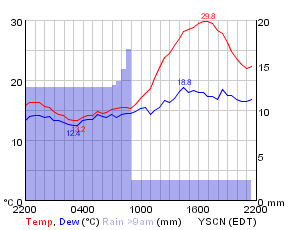 was noticeable as we had to point the nose into the wind to keep lined up
with the runway. Neil told me that an alternative to crabbing onto the runway
was the wing-down method, where the newly-acquired sideslip skills become
highly relevant, ie keep the left (into-wind) wing down and use rudder to
keep the aircraft on the runway centreline. Neil let me take it down to 65
knots and 700 feet up before taking over and sideslipping in to a very smooth
landing, with me on the controls once more to feel the inputs.
was noticeable as we had to point the nose into the wind to keep lined up
with the runway. Neil told me that an alternative to crabbing onto the runway
was the wing-down method, where the newly-acquired sideslip skills become
highly relevant, ie keep the left (into-wind) wing down and use rudder to
keep the aircraft on the runway centreline. Neil let me take it down to 65
knots and 700 feet up before taking over and sideslipping in to a very smooth
landing, with me on the controls once more to feel the inputs.
On the ground Neil rolled out, braked and turned into the taxiway and then handed over to me to taxi back to the apron and park. I briefly considered putting it in between two parked planes before deciding that discretion was the better part of valour and I would just park beside the first one. I remembered Kerry's ROARS shutdown procedure and we were finished. I realised that my shirt was soaked in sweat - we'd been quite comfortable at 4500 feet but down at 1800 it was very noticeably warmer. (The history to the right shows that we landed at the hottest part of the day. It also shows that the rain had stopped at Camden by 10am.)
Back in the office we discovered the story of what had been dropped by the departing aircraft. It was the canopy from the Extra. Apparently the son had unlocked it because it was too hot. Ouch. Rob says they cost about $20,000 and are expensive to insure. Another lesson in how important those checks are...
Tomorrow, weather permitting, I'll start stall training with Kerry. The storms which came through about 10pm have moved on now, but things were quite lively for a while there - see the images below. [Actually there was steady rain on Sunday and no flying]
Click thumbnails to enlarge.
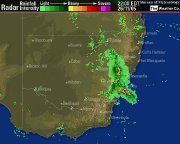 NSW radar |
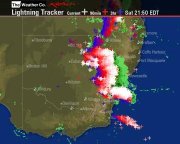 NSW lightning |
